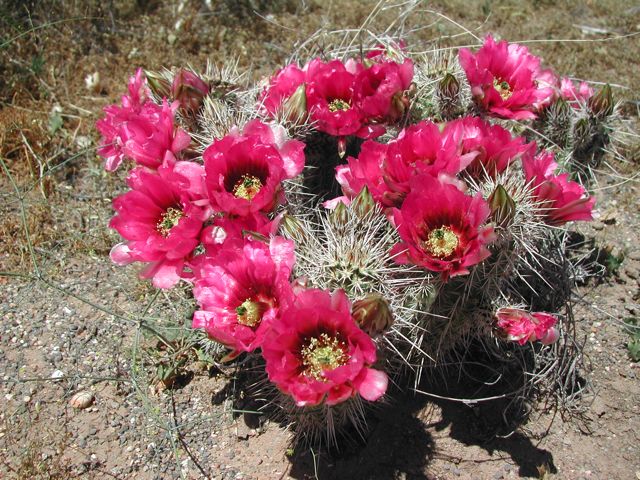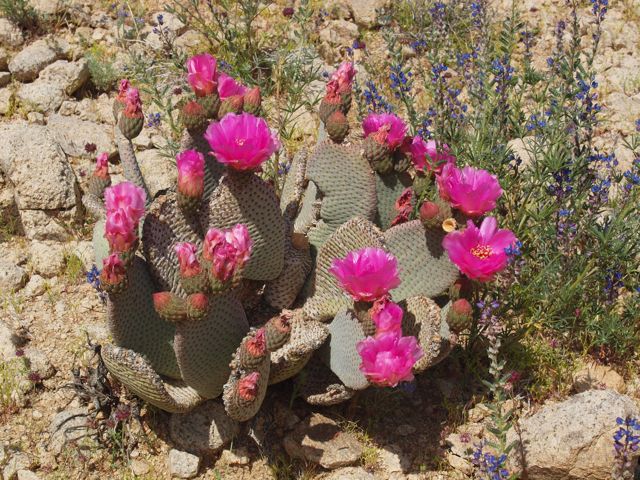 Outdoor Cactus Culture - March 20, 2019 Jeff Schalau, Agent, Agriculture & Natural Resources University of Arizona Cooperative Extension, Yavapai County Cacti are icons of Arizona and, given their ability to survive with little water, should be featured more often in urban landscapes. Cacti and many succulents are native to the new world and can be found from Canada’s plains to the southern tip of South America. These tough plants have many unique growth forms, produce striking flowers, and are easy to propagate and grow. Cacti and succulents can also be used effectively to create natural barriers that improve home security or curb unwanted foot traffic across your property. Cacti are easily transplanted from one location to another. In the low deserts, this can be done year round. However, in our area, the best time to transplant cacti is between the months of March and October. Warmer temperatures favor more rapid root growth and quicker establishment. To avoid injury, wear gloves and use several layers of newspaper to handle the spiny top portions. When transplanting outdoor cacti, care should be taken to note the orientation of the cactus plant before transplanting. The south and southwest sides of these plants become toughened and resistant to sunburn. The tender north and east sides can become sunburned and may rot if exposed to the intense sun. Simply mark the north side with chalk or masking tape before transplanting. To begin transplanting small cacti, cut the shallow roots by forcing a sharp shovel into the soil completely around the plant at a distance of about one foot from the base. Then, dig under and carefully pry and lift the plant out of the ground. Try to minimize injury to the plant. Allow any loose soil to fall away from the roots. When transplanting larger specimens such as ocotillo and saguaro cactus, it is best to use reputable and experienced professionals. Cleanly prune off any damaged roots and dust the ends and any other wounds with elemental sulfur (available at most nurseries/garden centers) to prevent rot and hasten callousing (healing). Cactus transplants should be placed in a shaded, open area for one or two weeks to allow cut roots to callous over before transplanting. Replant cactus into dry soil and do not irrigate until new growth appears at the apex (tips) of the plant. This may take several weeks. Remember to orient the plant with the chalk/masking tape mark facing north. Note: Do not unlawfully collect native cactus from Arizona’s public, private, or State Trust lands. Arizona’s Native Plant Law prohibits wild collection of native cactus without permission from the owner and a collection permit. For more information, consult the Arizona Department of Agriculture’s Plant Services Division at (602) 542-3578 or on the Internet at https://agriculture.az.gov/plantsproduce/native-plants. Well-drained sandy or gravelly loams are ideal for most cacti. Avoid locations where soil is saturated for extended periods. Heavy clay soils are generally too poorly drained for cacti to thrive. Also, do not overcrowd cactus. Allow space for air to freely circulate. Some small cactus species prefer to grow in partial shade. Plant these in appropriate locations. Care of cactus is minimal but attention to a few critical factors will enhance your success. Do not cultivate or otherwise disturb the soil within several feet of the plant base. This could injure the shallow root system. Crushed granite, natural stone, or organic surface mulches may be used for aesthetic or protective purposes. Do not mulch with any materials that reflect or intensify heat. Likewise, do not use plastic sheeting for weed barriers. Irrigation is typically not necessary. However, during periods of extended drought, some irrigation will enhance growth and flowering. This can be done about once every two to three weeks during the summer months. Do not over-irrigate as this could cause root rot. Cacti planted outdoors do not need fertilization. These beautiful and interesting plants make excellent drought tolerant additions to your landscape. Visit the online edition for additional information (see URL below). Follow the Backyard Gardener on Twitter – use the link on the BYG website. If you have other gardening questions, call the Master Gardener help line in the Camp Verde office at 928-554-8992 or e-mail us at verdevalleymg@gmail.com and be sure to include your name, address and phone number. Find past Backyard Gardener columns or provide feedback at the Backyard Gardener web site: http://cals.arizona.edu/yavapai/anr/hort/byg/. Photos  Strawberry hedgehog cactus (Echinocereus fasciculatus, photo by Sue Smith @ http://cals.arizona.edu/yavapaiplants).
Strawberry hedgehog cactus (Echinocereus fasciculatus, photo by Sue Smith @ http://cals.arizona.edu/yavapaiplants). Beavertail cactus (Opuntia basilaris, photo by Sue Smith @ http://cals.arizona.edu/yavapaiplants).
Beavertail cactus (Opuntia basilaris, photo by Sue Smith @ http://cals.arizona.edu/yavapaiplants). Parry's agave (Agave parryi) damage, (Steven Katovich, USDA Forest Service, Bugwood.org).
Parry's agave (Agave parryi) damage, (Steven Katovich, USDA Forest Service, Bugwood.org).Additional Resources Cactus, Agave, Yucca, and Ocotillo, University of Arizona Cooperative Extension extension.arizona.edu/sites/extension.arizona.edu/files/pubs/az1225.pdf Problems and Pests of Agave, Aloe, Cactus and Yucca, University of Arizona Cooperative Extension extension.arizona.edu/sites/extension.arizona.edu/files/pubs/az1399.pdf Yavapai County Native & Naturalized Plants, University of Arizona Cooperative Extension, Yavapai County cals.arizona.edu/yavapaiplants/ Guide to Common Cactus and Succulents of Tucson, Tucson Cactus and Succulent Society wise.arizona.edu/sites/default/files/Common%20cacti%20and%20succulents-1.pdf |